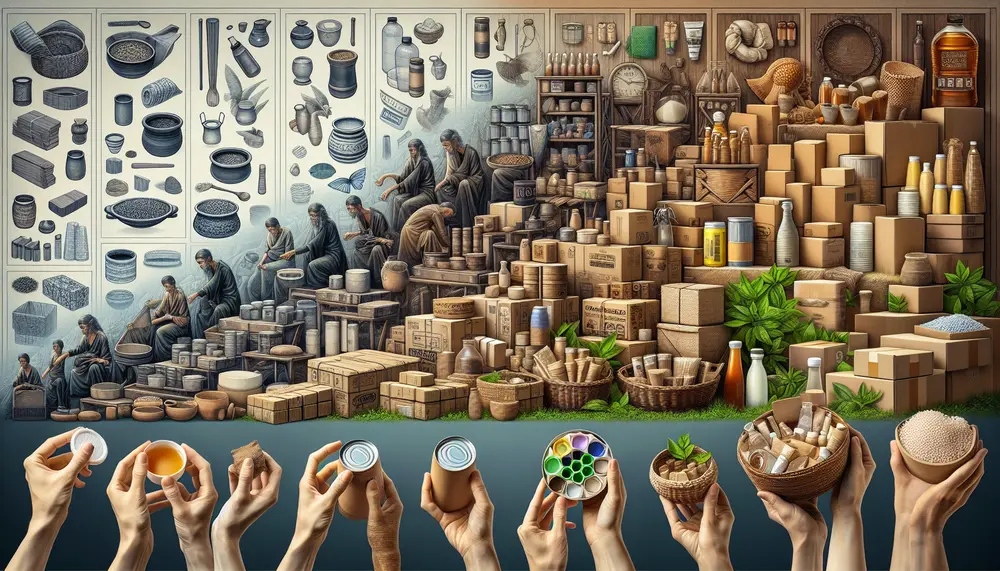Table of Contents:
The Dawn of Packaging: Natural Materials and Early Innovations
Packaging has played a crucial role in human development, safeguarding our food and goods from the earliest of times. The dawn of packaging saw our ancestors using whatever materials were at hand, instinctively wrapping or storing their food and valuable items to protect them from the environment and make them easier to carry.
In this period, humans demonstrated remarkable creativity. Natural materials such as gourds were hollowed out to make containers, while large leaves and woven grasses were adeptly turned into makeshift wraps and bags. These organic choices were not only biodegradable and readily available but also reflected a deep understanding of utilizing the natural world efficiently without waste.
As societies progressed, there was also the need to trade, necessitating even more durable packaging forms. Early innovations saw the use of wood, specifically carved wooden boxes and barrels, which could withstand long journeys and protect the goods within from the elements. In coastal regions, shells were often used to hold small amounts of precious materials like spices or oils, showcasing early trade's global footprint.
The evolution of packaging materials displays the adaptability and resourcefulness of humankind, laying the groundwork for future advancements that continue to shape the industry today. Through necessity and ingenuity, these early forms of packaging fostered the development of commerce and paved the way for the complex packaging methods we have become accustomed to.
Paper Revolution: China's Ancient Contribution to Packaging
The transition from natural to manufactured packaging materials marked a pivotal point in packaging history. One of the most significant contributions to this revolution came from ancient China with the invention of paper in the 1st or 2nd century BC. This groundbreaking innovation changed the way goods were packed, stored, and distributed across the world.
Prior to paper, materials such as silk were used for recording important information, but the cost and rarity of silk made it impractical for wider use. The advent of paper as a packaging material not only democratized the recording and dissemination of information but also ushered in a new era in packaging. Lightweight, versatile, and easier to produce than other materials of the time, paper provided an accessible and effective medium for wrapping items both large and small.
In addition to its use in wrapping, paper's role in packaging evolved with the development of processes to create paper from wood cellulose in 1867, enhancing its strength and durability. This progression allowed paper to become a staple in the packaging industry, contributing to its ongoing story of innovation and adaptation.
The Evolution of Packaging: A Comparison of Past and Present
| Era | Materials | Techniques | Environmental Impact |
|---|---|---|---|
| Ancient Times | Organic materials (leather, wood) | Handmade, simple tools | Low - materials were biodegradable |
| Industrial Revolution | Paper, glass, metals | Mass production | Medium - mass production began to increase waste |
| 20th Century | Plastics, aluminium, cardboard | Automation, global distribution | High - rise of non-biodegradable waste |
| Modern Days | Bioplastics, recycled materials | Advanced manufacturing, smart packaging | Variable - shift towards sustainability, but high volume of consumption |
The Birth of Paper Bags and Their Evolution
The invention of the paper bag was a transformative milestone in packaging history. With the first commercial production of paper bags in Bristol, England in 1844, an era of convenience and practicality in packaging began. These early paper bags were simple flat envelopes, but they represented a significant leap from improvised wrappings to a standardized packaging solution.
The innovation did not stop with their initial creation. In the United States, Francis Wolle invented the paper bag manufacturing machine in 1852, automating the production process and making paper bags more widely available. By the 1870s, enhancements in bag design led to stronger, more versatile bags with gussets and flat bottoms, allowing these bags to stand upright and hold more goods.
Furthermore, advancements in adhesives and manufacturing technology in the 1920s saw the creation of paper bags able to withstand more significant weight, without coming apart or breaking. This evolution of the paper bag captured the synergy between industrial progress and packaging needs, reflecting the growing consumer culture and the demand for convenient, reliable packaging.
Packaging Through the Ages: Key Historical Insights
What were the earliest forms of packaging used by humans?
The earliest forms of packaging involved natural materials readily available in the environment. These included gourds, leaves, woven grasses, and animal organs. They also used shells and carved wood to create containers for storing and trading goods.
How did the invention of paper change packaging?
Paper, invented in China between the 1st and 2nd century BC, revolutionized packaging by providing a lightweight, versatile, and more accessible material. It democratized the recording of information and was used for wrapping items, with further advances being made once paper was produced from wood cellulose in 1867.
When were the first commercial paper bags manufactured?
The first commercial production of paper bags took place in Bristol, England, in 1844. These bags evolved significantly over time, especially after the invention of the paper bag manufacturing machine by Francis Wolle in the USA in 1852.
What developments occurred in the evolution of metal and glass packaging?
Glass containers have been used since ancient Egypt, around 1500 BC, while significant advances in glass manufacturing occurred with the invention of the blowpipe. Metal packaging origins trace back to the invention of tin-plated cans in the 19th century, which evolved with the introduction of canned food preservation methods and the can opener in the late 1870s.
What is the environmental impact of modern packaging materials compared to ancient times?
Ancient packaging materials were predominantly organic and biodegradable, resulting in a low environmental impact. Modern packaging materials, such as plastics and aluminium, increased the volume of non-biodegradable waste. However, there is a growing shift towards sustainability with the development of bioplastics and the use of recycled materials.






